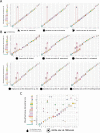The brittle star genome illuminates the genetic basis of animal appendage regeneration
- PMID: 39030276
- PMCID: PMC11310086
- DOI: 10.1038/s41559-024-02456-y
The brittle star genome illuminates the genetic basis of animal appendage regeneration
Abstract
Species within nearly all extant animal lineages are capable of regenerating body parts. However, it remains unclear whether the gene expression programme controlling regeneration is evolutionarily conserved. Brittle stars are a species-rich class of echinoderms with outstanding regenerative abilities, but investigations into the genetic bases of regeneration in this group have been hindered by the limited genomic resources. Here we report a chromosome-scale genome assembly for the brittle star Amphiura filiformis. We show that the brittle star genome is the most rearranged among echinoderms sequenced so far, featuring a reorganized Hox cluster reminiscent of the rearrangements observed in sea urchins. In addition, we performed an extensive profiling of gene expression during brittle star adult arm regeneration and identified sequential waves of gene expression governing wound healing, proliferation and differentiation. We conducted comparative transcriptomic analyses with other invertebrate and vertebrate models for appendage regeneration and uncovered hundreds of genes with conserved expression dynamics, particularly during the proliferative phase of regeneration. Our findings emphasize the crucial importance of echinoderms to detect long-range expression conservation between vertebrates and classical invertebrate regeneration model systems.
© 2024. The Author(s).
Conflict of interest statement
The authors declare no competing interests.
Figures
















References
-
- O’Hara, T. D., Hugall, A. F., Woolley, S. N. C., Bribiesca-Contreras, G. & Bax, N. J. Contrasting processes drive ophiuroid phylodiversity across shallow and deep seafloors. Nature565, 636–639 (2019). - PubMed
-
- Vistisen, B. & Vismann, B. Tolerance to low oxygen and sulfide in Amphiura filiformis and Ophiura albida (Echinodermata: Ophiuroidea). Mar. Biol.128, 241–246 (1997).
-
- Vopel, K., Thistle, D. & Rosenberg, R. Effect of the brittle star Amphiura filiformis (Amphiuridae, Echinodermata) on oxygen flux into the sediment. Limnol. Oceanogr.48, 2034–2045 (2003).
-
- Dupont, S. & Thorndyke, M. Bridging the regeneration gap: insights from echinoderm models. Nat. Rev. Genet.8, 320 (2007).
MeSH terms
Grants and funding
- URF\R1\191161/Royal Society
- NIF\R1\222125/Royal Society
- BB/V01109X/1/RCUK | Biotechnology and Biological Sciences Research Council (BBSRC)
- BB/W017865/1/RCUK | Biotechnology and Biological Sciences Research Council (BBSRC)
- RPG-2021-436/Leverhulme Trust
- JP 19K06620/Japan Society for the Promotion of Science London (JSPS London)
- 253016979/Vetenskapsrådet (Swedish Research Council)
- 40013965/Fonds De La Recherche Scientifique - FNRS (Belgian National Fund for Scientific Research)
- T.0169.20/Fonds De La Recherche Scientifique - FNRS (Belgian National Fund for Scientific Research)
- 2131297/National Science Foundation (NSF)
- MARISTEM/EC | Horizon 2020 Framework Programme (EU Framework Programme for Research and Innovation H2020)
- ASSEMBLE (227799)/EC | EC Seventh Framework Programm | FP7 Research infrastructures (FP7-INFRASTRUCTURES - Specific Programme "Capacities": Research Infrastructures)
LinkOut - more resources
Full Text Sources

